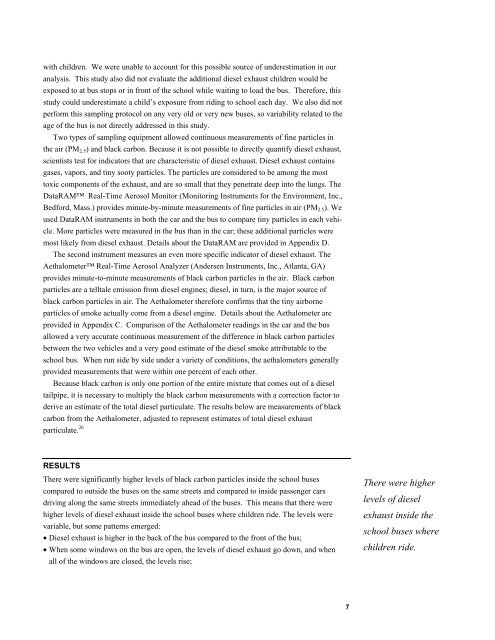NRDC: No Breathing in the Aisles: Diesel Exhaust Inside School ...
NRDC: No Breathing in the Aisles: Diesel Exhaust Inside School ...
NRDC: No Breathing in the Aisles: Diesel Exhaust Inside School ...
Create successful ePaper yourself
Turn your PDF publications into a flip-book with our unique Google optimized e-Paper software.
with children. We were unable to account for this possible source of underestimation <strong>in</strong> our<br />
analysis. This study also did not evaluate <strong>the</strong> additional diesel exhaust children would be<br />
exposed to at bus stops or <strong>in</strong> front of <strong>the</strong> school while wait<strong>in</strong>g to load <strong>the</strong> bus. Therefore, this<br />
study could underestimate a child’s exposure from rid<strong>in</strong>g to school each day. We also did not<br />
perform this sampl<strong>in</strong>g protocol on any very old or very new buses, so variability related to <strong>the</strong><br />
age of <strong>the</strong> bus is not directly addressed <strong>in</strong> this study.<br />
Two types of sampl<strong>in</strong>g equipment allowed cont<strong>in</strong>uous measurements of f<strong>in</strong>e particles <strong>in</strong><br />
<strong>the</strong> air (PM2.5) and black carbon. Because it is not possible to directly quantify diesel exhaust,<br />
scientists test for <strong>in</strong>dicators that are characteristic of diesel exhaust. <strong>Diesel</strong> exhaust conta<strong>in</strong>s<br />
gases, vapors, and t<strong>in</strong>y sooty particles. The particles are considered to be among <strong>the</strong> most<br />
toxic components of <strong>the</strong> exhaust, and are so small that <strong>the</strong>y penetrate deep <strong>in</strong>to <strong>the</strong> lungs. The<br />
DataRAM Real-Time Aerosol Monitor (Monitor<strong>in</strong>g Instruments for <strong>the</strong> Environment, Inc.,<br />
Bedford, Mass.) provides m<strong>in</strong>ute-by-m<strong>in</strong>ute measurements of f<strong>in</strong>e particles <strong>in</strong> air (PM2.5). We<br />
used DataRAM <strong>in</strong>struments <strong>in</strong> both <strong>the</strong> car and <strong>the</strong> bus to compare t<strong>in</strong>y particles <strong>in</strong> each vehicle.<br />
More particles were measured <strong>in</strong> <strong>the</strong> bus than <strong>in</strong> <strong>the</strong> car; <strong>the</strong>se additional particles were<br />
most likely from diesel exhaust. Details about <strong>the</strong> DataRAM are provided <strong>in</strong> Appendix D.<br />
The second <strong>in</strong>strument measures an even more specific <strong>in</strong>dicator of diesel exhaust. The<br />
Aethalometer Real-Time Aerosol Analyzer (Andersen Instruments, Inc., Atlanta, GA)<br />
provides m<strong>in</strong>ute-to-m<strong>in</strong>ute measurements of black carbon particles <strong>in</strong> <strong>the</strong> air. Black carbon<br />
particles are a telltale emission from diesel eng<strong>in</strong>es; diesel, <strong>in</strong> turn, is <strong>the</strong> major source of<br />
black carbon particles <strong>in</strong> air. The Aethalometer <strong>the</strong>refore confirms that <strong>the</strong> t<strong>in</strong>y airborne<br />
particles of smoke actually come from a diesel eng<strong>in</strong>e. Details about <strong>the</strong> Aethalometer are<br />
provided <strong>in</strong> Appendix C. Comparison of <strong>the</strong> Aethalometer read<strong>in</strong>gs <strong>in</strong> <strong>the</strong> car and <strong>the</strong> bus<br />
allowed a very accurate cont<strong>in</strong>uous measurement of <strong>the</strong> difference <strong>in</strong> black carbon particles<br />
between <strong>the</strong> two vehicles and a very good estimate of <strong>the</strong> diesel smoke attributable to <strong>the</strong><br />
school bus. When run side by side under a variety of conditions, <strong>the</strong> aethalometers generally<br />
provided measurements that were with<strong>in</strong> one percent of each o<strong>the</strong>r.<br />
Because black carbon is only one portion of <strong>the</strong> entire mixture that comes out of a diesel<br />
tailpipe, it is necessary to multiply <strong>the</strong> black carbon measurements with a correction factor to<br />
derive an estimate of <strong>the</strong> total diesel particulate. The results below are measurements of black<br />
carbon from <strong>the</strong> Aethalometer, adjusted to represent estimates of total diesel exhaust<br />
particulate. 26<br />
RESULTS<br />
There were significantly higher levels of black carbon particles <strong>in</strong>side <strong>the</strong> school buses<br />
compared to outside <strong>the</strong> buses on <strong>the</strong> same streets and compared to <strong>in</strong>side passenger cars<br />
driv<strong>in</strong>g along <strong>the</strong> same streets immediately ahead of <strong>the</strong> buses. This means that <strong>the</strong>re were<br />
higher levels of diesel exhaust <strong>in</strong>side <strong>the</strong> school buses where children ride. The levels were<br />
variable, but some patterns emerged:<br />
• <strong>Diesel</strong> exhaust is higher <strong>in</strong> <strong>the</strong> back of <strong>the</strong> bus compared to <strong>the</strong> front of <strong>the</strong> bus;<br />
• When some w<strong>in</strong>dows on <strong>the</strong> bus are open, <strong>the</strong> levels of diesel exhaust go down, and when<br />
all of <strong>the</strong> w<strong>in</strong>dows are closed, <strong>the</strong> levels rise;<br />
7<br />
There were higher<br />
levels of diesel<br />
exhaust <strong>in</strong>side <strong>the</strong><br />
school buses where<br />
children ride.
















